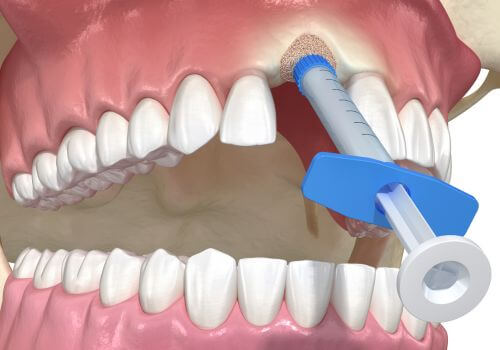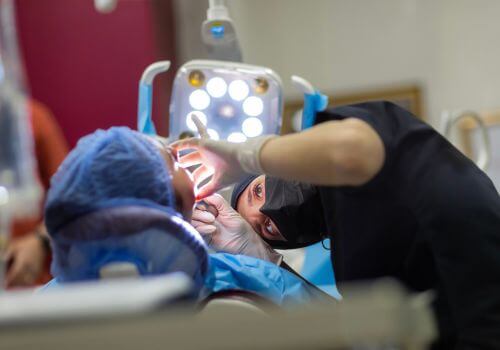Imagine this: you’ve just had a tooth extracted and feel relieved the hardest part is over. Then your dentist mentions something called a “bone graft.” Suddenly, what felt like a simple procedure now seems more complicated, and you may be left wondering—is this really necessary?
You’re not alone. Many patients have questions when bone grafts are recommended. It can feel overwhelming to think about another treatment, especially while you’re still adjusting to the idea of a missing tooth.
That’s why we’ve created this guide—to answer your questions, ease your concerns, and help you understand when and why a bone graft might be an important step after tooth extraction.
What Is a Dental Bone Graft?
A dental bone graft is a type of surgery that takes place following an extraction. During the procedure, an oral surgeon replaces missing bone with material from another part of your body or with synthetic material. After a tooth extraction, the jawbone often shrinks in width and height in a process called resorption.
Think of the grafting material as a framework for new bone growth. Over time, your body regenerates bone to replace the graft material, increasing jaw volume and density.

Why Might You Need a Bone Graft After an Extraction?
There are several reasons your dentist may recommend a bone graft following tooth removal:
Preserving Bone Structure
After an extraction, the bone that once supported the tooth no longer receives stimulation from chewing. Without stimulation, the bone deteriorates. A bone graft helps maintain the bone volume and shape of your jaw.
Planning for Dental Implants
Sufficient bone is essential if you’re considering a dental implant to replace your extracted tooth. Implants need solid bone for stability and support, and a bone graft creates an adequate foundation.
As dental professionals, we often recommend socket preservation grafts immediately after extraction when a patient plans to get an implant later. This proactive approach typically saves time and reduces the need for more extensive grafting procedures down the road.
Preventing Facial Structure Changes
Significant bone loss can alter your facial appearance, creating a sunken look that makes you look older. Grafting helps prevent these changes by maintaining proper facial contours.
Support for Adjacent Teeth
When bone deterioration occurs after an extraction, neighboring teeth may shift or become unstable due to the loss of support. A bone graft helps prevent these problems.
Types of Bone Grafts Used After Tooth Extraction
Dentists have several types of bone graft materials to choose from, each with unique benefits. Your dental team will recommend the option that best fits your needs.
-
Autografts come from your own body—often the hip, chin, or back of the jaw. Since the bone is naturally yours, it integrates well and supports strong healing.
-
Allografts use human donor bone that has been carefully screened, processed, and sterilized for safe use.
-
Xenografts are derived from non-human sources, usually bovine (cow) bone. The bone is treated to remove all organic material, leaving just the mineral structure to support new growth.
-
Synthetic grafts are made from biocompatible materials like calcium phosphate or calcium sulfate. These grafts encourage bone growth without any risk of disease transmission

The Bone Grafting Procedure
Knowing what to expect during and after a bone graft can help reduce anxiety about the procedure. Most bone grafts are placed immediately after a tooth extraction while the socket is still open.
Here’s what typically happens during the graft:
-
The dentist cleans the extraction site thoroughly.
-
The grafting material is placed into the socket.
-
A protective membrane is placed over the graft.
-
The gum tissue is stitched closed.
The grafting process usually only adds a few minutes to the overall extraction.
After the procedure, it’s normal to experience mild discomfort, swelling, or bruising, which generally improve within a few days. Small bone particles may also appear in the gum tissue as you heal—this is completely normal. Full healing and integration of the graft usually take 3–6 months, though the timeline can vary depending on the patient.
Your dentist will provide detailed aftercare instructions, including how to care for the area, which foods to avoid, and when to return for follow-up visits. Following these guidelines closely helps ensure smooth healing and reduces the risk of complications. If you notice any unusual symptoms or have concerns, contact your dentist promptly.
Potential Risks and Complications
While bone grafting is generally safe, potential complications include:
Infection
Though rare with proper technique and sterilization protocols, infection remains possible with any surgical procedure.
Graft Failure
Sometimes, the body doesn’t integrate the graft material properly, resulting in graft failure. This complication is most common in patients who smoke or have certain medical conditions.
Nerve Damage
In very rare cases, bone grafting can cause nerve damage, causing numbness or tingling of the mouth or face.
Sinus Complications
For upper jaw grafts near the sinus cavity, there’s a small risk of sinus membrane perforation.
Do You Need a Dental Bone Graft?
Getting a bone graft after a tooth extraction is an investment in your oral health. While not necessary in every situation, it offers significant benefits for many patients, especially those considering implants or concerned about preserving facial structure. Your dentist will assess your unique situation and help you determine whether a bone graft would support your oral health goals. When performed by qualified professionals, bone grafts have high success rates and can significantly improve outcomes following tooth extraction. Proper aftercare is also vital to ensure proper healing.
Bone grafting may sound scary, but realistically, it usually only adds a few minutes to an extraction. If you need an extraction, schedule a consultation with your dentist today!

